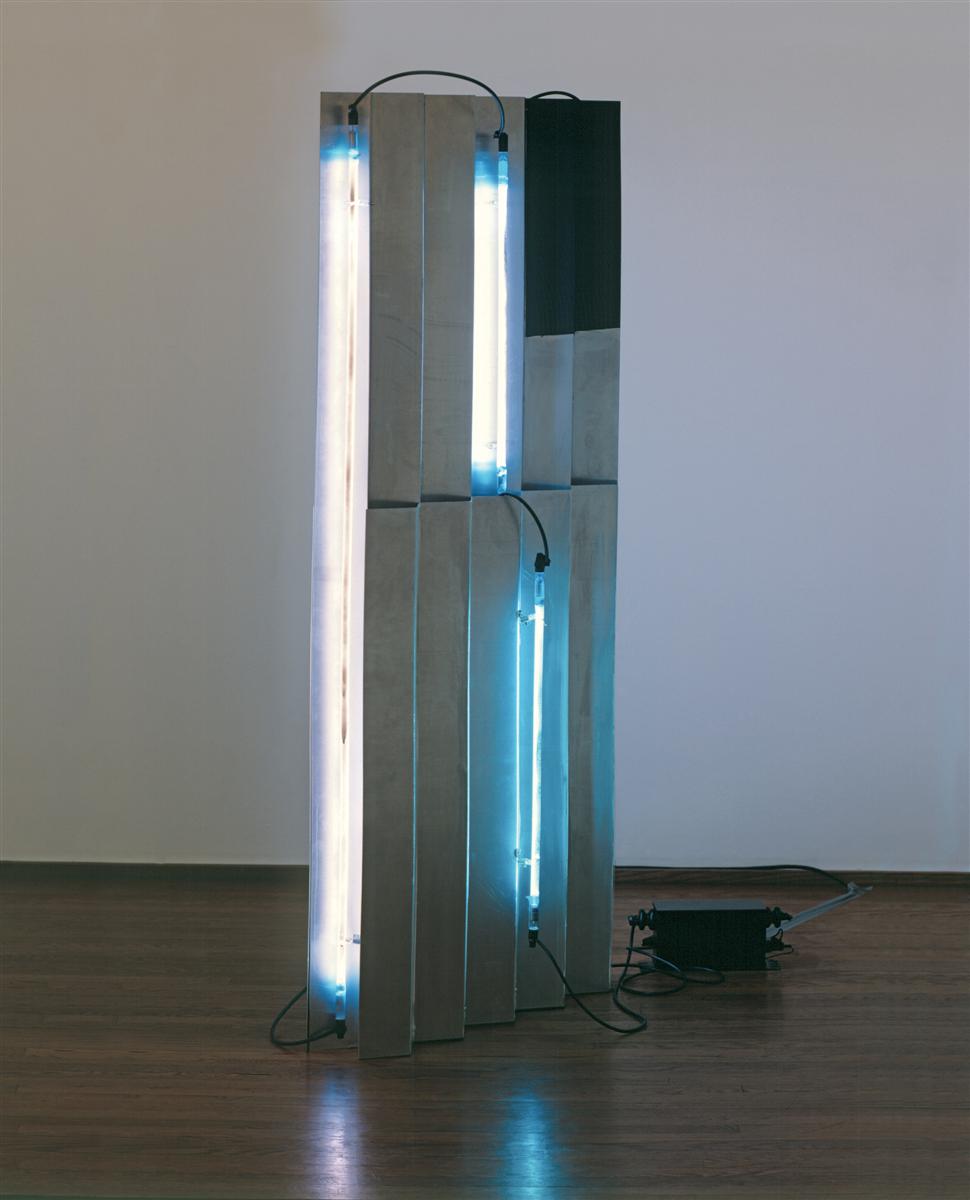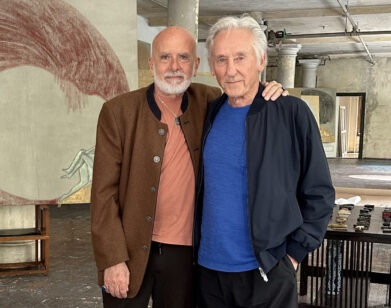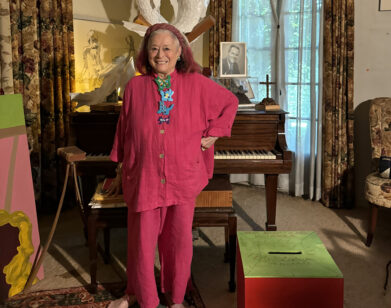Keith Sonnier
Keith Sonnier’s sculptural works have been changing people’s perceptions about what art is or might be for the past 40 years. With several major shows this spring, Sonnier once again asserted his magisterial position in that strange alternate universe, the art world. We spoke to Sonnier in his studio on Chambers Street in lower Manhattan, where he was putting the final touches to some works and just beginning others.
MAX BLAGG: When did you first arrive in New York from that sleepy little town in Louisiana?
KEITH SONNIER: I left my home in Mamou in ’66, not without tears, for graduate school at Rutgers. I moved to New York right after graduating.
MB: Who were the other artists around then?
KS: The art world was a lot smaller then. There was a school of my generation, like Barry Le Va, Lynda Benglis, Alan Saret, Bill Bollinger, Jackie Winsor — a whole variety from different backgrounds. We did lots of projects together. Artists would help other artists, dancers, or musicians to realize their projects and performances.
MB: Was it more of a communal scene then?
KS: It was much more communal. It was the late ’60s, there was a very different attitude toward artists and work. There was very little money involved. I mean, this is before contemporary art was sold for very large sums. I think we were amazed that what we were making would even be bought. Our type of work was somehow counterculture. We chose materials that were not “high art”; we weren’t working in bronze, or paint, even. We were using materials that weren’t previously considered art materials. They were deliberately chosen to psychologically evoke certain kinds of feelings. I use psychologically loaded materials.
MB: A simple piece of fabric, like the scraps of silk in your early works, has a powerful narrative-curtains flapping, frogs croaking, an adulterer just left the premises, all kinds of stories.
KS: Yes, the pieces were abstract, but they were loaded with undertones of certain kinds of impulses. They were kinda sexy. I think that your personal history is part of your basic language, and you will always incorporate these impulses in making work. I was very involved in incorporating the five senses at that point; not necessarily just a visual association. How things looked and smelled and even tasted.
MB: Does that have anything to do with the fact that you’re a great cook?
KS: Well, a lot of artists are good cooks too, but coming from a culture that was very concerned with food, I was very interested in that from the start. That was an essential part of our upbringing. If you’re interested in food, you’re interested in lots of different aspects of culture. And it’s like being interested in the music from a certain area, or writing, or whatever-food is part of that, too. And a lot of my reading, especially the early reading, was very concerned with the anthropological aspects of early culture, and, of course, food and cooking and flame, and all of that entered into some of these early ideas, which I didn’t realize at the time. They happened much later in the work when I became interested in the other aspects — I was using light, and then all of a sudden I became interested in the electricity as well. It’s like going back to the source of a material or a mineral or a scent: You go back to the essence of what the thing is about.
MB: You’re showing at Sadie Coles’s gallery in London this month [June], a lot of early work, which looks incredibly modern and new today.
KS: In London, we’re re-creating some of the more environmental works that dealt with just raw color pigment, like an early fluorescent room piece called Dis-Play that was made in 1969 in New York and then shown at the Whitney and in several European museums.
MB: So with something like that you re-create the piece in a new location, so that becomes a new original work of art, right?
KS: Yes, because these pieces are environmental in nature, they adapt quite fluidly to different kinds of room situations. Actually, the show at Sadie’s was originally a set-props used in early videotapes-which later became the artwork Dis-Play. Dis-Play was set up in my studio for quite a long time, filled with manipulated, extruded objects: mirrors and planks of wood, and foam rubber, and lights of different kinds-strobe lights, ultraviolet lights. It was a theatrical set, and several of the early tapes were done in this setting, and they will be shown simultaneously.
MB: When you revisit early works, is the tactile sense different?
KS: I think it’s like an actor doing a play. You reassess that language, and you re-project it.
MB: Do the pieces come out different?
Funny you saw a sea creature. People call that my Frederick’s of Hollywood period. Keith Sonnier
KS: There are historians who will say, “Oh, well, now this is different because they don’t make this color anymore, or they don’t make this foam anymore . . .” These are minor things. It’s the overall picture of the form and the language and how it’s used. It’s just like a writer: You might, after you write a text, refine it and add to it. The edit is very important also in art. You really have to rearrange the language, too.
MB: You possess your share of the shaman. I remember one night I saw this piece in your studio and it really seemed alive. It was like a manta ray gliding about in the dark. I was sober, too.
KS: Funny you saw a sea creature. People call that my “Frederick’s of Hollywood” period.
MB: What’s in the show at Mary Boone?
KS: It’s work from the ’80s-large, freestanding sculptural works. This work is the key to the much larger architectural pieces that were made later on in my career, when I began to make very large commission works. One piece is the prototype for my installation at Munich Airport, which is a kilometer-long artwork. And there is the “Kiosk” piece, the work that led to a lot of the architecture and light works.
MB: You make a beautiful sculpture, then you realize you can make it the size of a building.
KS: Yes, and you can, and actually have people move through it. Sculpture, for me, provides that environmental discipline where you actually move in and around it. And if you have a good collaboration with an architect, to combine those aspects of color — I’m talking about color becoming a form within the building — that is a very different approach. I love contemporary architecture, which makes collaboration more interesting-and you have to be able to collaborate. It’s like making a film, in a way: Everyone is a part of the team.
MB: And how do you work with the architects?
KS: It tends to work best when one can collaborate at the earliest junction, because you save money. You can get through ideas much quicker because it’s not finite yet.
MB: Right now you are working on two large-scale commissions?
KS: Yes, a soccer stadium in Switzerland and a new casino in Las Vegas. I’m not a big sports fan. I don’t like gambling either. What led to the casino project is that I’m doing a series of architecturally based chandeliers. They began as small chandeliers, designed for my house on Long Island. I wanted to change the look of the lighting inside the house and make the lighting an artwork. Anyway, the clients from Vegas saw a small version and wanted something bigger. It went from three feet across to some that are 35 to 50 feet across.
MB: So these are monumental sculptures.
KS: They’re very large sculptural hanging works that are sited above escalators, so as you go up the escalators, you go into that —
MB: That zone of light. But the work is also like a three-dimensional abstract-expressionist piece.
KS: Well, the particular gestural quality of these chandeliers relates to some of the earlier works where different kinds of loops of light were used, and they were played against each other— like incandescent light and neon light, and different kinds of light-one light bleeding out another light, in the same way that one color in a painting will influence the color laid up next to it. The light is a trapped gas. A gaseous light has more extension, and it begins to make color become volumetric.
MB: And how do you think light affects people walking into that kind of visual zone?
KS: I think it’s an obvious up! Moods change.
MB: This new body of work-the “aha!” moment was a neon sign you saw in a bar?
KS: I saw a very curious Texas longhorn sign in a bar in Texas a few years back, and I thought I’ve never used neon in these referential, animalistic ways. So I did a whole series of horn drawings. I spent a lot of time at the American Museum of Natural History, in their photographic archives, and I researched mammoth bones and anthropological sites.
MB: I’m curious as to how an artist’s mind works-from a neon sign to a mammoth bone.
KS: I love light in my work but I was never influenced by neon signage in itself, rather its effect on nature and architecture. You can’t ignore what’s around you, but at the same time, an artist who has a sophisticated form language knows how to pull in different elements, and readjust and redirect those. . . . So it becomes an engineering process, too.
MB: Sounds like a Ford plant. You seem to have a lot of technical know-how about how to make these things.
KS: I have an intuitive understanding of technology. [laughter from nearby assistants] And the way I incorporate technology in the work tends to humanize it a great deal.
MB: And that led to this crowd of animals in the studio now?
KS: Well, we have several projects going on in this particular studio, because upstairs is where the office is and the computer designing gets done, but downstairs the prototypes are made and the actual sculptures are assembled. Yes, The Herd is a series of freestanding works that, when they’re all together, looks like a herd of animals — wildebeests or something.
MB: Did you start out with the idea of a group?
You gotta work upstairs to downstairs! You gotta work both ends of the street. Keith Sonnier
KS: Well, now I think of them that way, and I’d love to show them that way-as a herd-and they almost look like some kind of humanoid, animalistic robot. But the focus is really on the material and the stance, and the actual electrical housing becomes very important — that you really see where the energy from one source is going to another source, and one color moving to another color. And you physically see this trapped energy capped with these plastic caps and stuff that are all on these pieces. I’m almost finished now, but I’ve been three years on this series. I have to stay with an idea-it’s like writing a novel — I’ve had to stay with this idea three years to really home in and complete it.
MB: You seem to be so energized and prolific. Do you ever hit a wall when you are trying to make something new?
KS: I think everyone at some point comes up against a wall. Curiously, though, if you continue working, you might readdress that idea from another direction. If you didn’t try something, you’d never have anything; if you didn’t make an attempt to make the work, it wouldn’t exist. There have been times when I could not work, and I would just go and sit down in the studio and wait to see what might happen. You can’t always just go and take an exotic trip and come back and make something.
MB: So you just put on your milking cap and go into the studio every day —
KS: Well, this is New York. You gotta work from upstairs to downstairs! You gotta work both ends of the street to have a career. Because it’s not just fabricating an artwork. These works have to go out into the world; they have to go to market. This art on the hoof has to be moved; it’s got to go to the slaughterhouse at some point. Keep those dogies rollin’!







